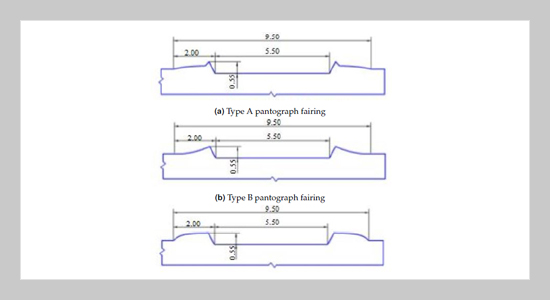REFERENCES
- [1] Fu, Y.T., Yang, H., Ding, J.L., “Multiple operating mode ANFIS modelling for speed control of HSEMU,” IET Intelligent Transport Systems, Vol. 12, No. 1, pp. 31−40 (2018).
- [2] Baker, C., “The flow around high speed trains,” Journal of Wind Engineering and Industrial Aerodynamics, Vol. 98, No. 6, pp. 266−298 (2010).
- [3] Wu, Z.F., Yang, E.Y., Ding, W.C., “Design of large-scale streamlined head cars of high-speed trains and aerodynamic drag calculation,” Archives of Transport, Vol. 44, No. 4, pp. 89-97 (2017).
- [4] Tian, H.Q., “Formation mechanism of aerodynamic drag of high-speed train and some reduction measures,” Journal of Central South University of Technology, Vol. 16, No. 1, pp. 166-171 (2009).
- [5] Xu, G., Liang, X.F., Yao, S.B., Chen, D.W. and Li, Z.W., “Multi-objective aerodynamic optimization of the streamlined shape of high-speed trains based on the Kriging model,” Journal Pone, Vol. 12, No. 1, pp. 1-14 (2017).
- [6] Ku, Y.C., Rho, J.H., Yun, S.H., Kwak, M.H., Kim, K.H. and Lee, D.H., “Optimal cross-sectional area distribution of a high-speed train nose to minimize the tunnel micro-pressure wave,” Industrial Application, Vol. 42, pp. 965-976 (2010).
- [7] Wang, D.P., He, Z.K., Li, M.G. and Zhao, W.Z., “Numerical research on aerodynamic drag reduction optimization of EMU,” Journal of the China Railway Society, Vol. 33, No. 10, pp. 15-18 (2011).
- [8] Zhang, L., Yang, M.Z., Liang, X.F., “Experimental study on the effect of wind angles on pressure distribution of train streamlined zone and train aerodynamic forces,” Journal of Wind Engineering & Industrial Aerodynamics, Vol. 174, pp. 330-343 (2018).
- [9] Lu, W.T., Wang, Y., Zhang, C.Q., “Numerical simulation of aerodynamic noises in the far field of the high-speed train with considering bogies and connection windshields,” Journal of Vibroengineering, Vol. 19, No. 3, pp. 2262-2279 (2017).
- [10] Kwak, M., Yun, S., Lee, Y., Kwon, H., Kim, K. and Lee, D.H., “Optimum nose shape of a front-rear symmetric train for the reduction of the total aerodynamic drag,” Journal of Mechanical Science and Technology, Vol. 27, No. 12, pp. 3733-3743 (2013).
- [11] Iglesias, E.L., Thompson, D.J., Smith, M.G., “Component-based model to predict aerodynamic noise from high-speed train pantographs,” Journal of Sound and Vibration, Vol. 394, pp. 280-305 (2017).
- [12] Yang, H.X., Liu, D.M., “Numerical study on the aerodynamic noise characteristics of CRH2 high-speed trains,” Journal of Vibroengineering, Vol. 19, No. 5, pp. 3953-3967 (2017).
- [13] Tian, H.Q., “Study evolvement of train aerodynamics in China,” Journal of Traffic and Transportation Engineering, Vol. 6, No. 1, pp. 1-9 (2006).
- [14] Zhang, X.F., Xiao, Y.G., Deng, H.L., “Noise source localization investigation in high speed train based on microphone array,” Applied Mechanics and Materials, Vol. 103, pp. 285-291 (2012).
- [15] Liu, Z.Q., Ma, W.H., Luo, S.H., “A study on the aerodynamic safety of skirt board structure on maglev train,” Applied Mechanics and Materials, Vol. 138, pp. 836-841(2012).
- [16] Frid, A., “Skirts and barriers for reduction of wayside noise from railway vehicles-an experimental investigation with application to the BR185 locomotive,” Journal of Sound and Vibration, Vol. 267, pp. 709-719 (2003).
- [17] Jeong, S.M., Lee, S.A., Rho, J.H., “Research of high-speed train pantograph shape design for noise and drag reduction through computational analysis,” Journal of Fluids Engineering, Vol. 20, No. 2, pp. 67-72 (2015).
- [18] Xiao, J.P., Huang, Z.X., Chen, L., “Review of aerodynamic investigations for high speed train,” Mechanics in Engineering, Vol. 35, No. 2, pp. 1-12 (2013).
- [19] Wang, D.P., Zhao, W.Z., Ma, S.Q., “Application of CFD numerical simulation in high speed train design,” Journal of the China Railway Society, Vol. 29, No, 5, pp. 64-68 (2007).
- [20] Yang, F., Zheng, B.L., He, P.F., “Numerical simulation on aerodynamic noise of power collection equipment for high-speed trains,” Computer Aided Engineering, Vol. 19, No. 1, pp. 44-47 (2010).
- [21] Paz, C., Suárez, E., Gil, C., “Numerical methodology for evaluating the effect of sleepers in the underbody flow of a high-speed train,” Journal of Wind Engineering and Industrial Aerodynamics, Vol. 167, pp. 140-147 (2017).
- [22] Zhang, Z.Zh., Zhou, D., “Wind tunnel experiment on aerodynamic characteristic of streamline head of high speed train with different head shapes,” Journal of Central South University (Science and Technology), Vol. 44, No. 6, pp. 2603-2608 (2013).









